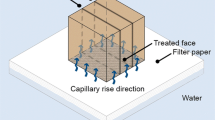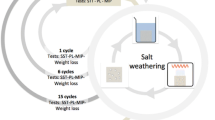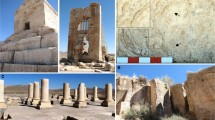Abstract
Consolidation is considered one of the major restoration treatments applied on cultural heritage. This kind of treatment is focused on to preserve the external weathered layers of stone reducing their degradation caused by external alteration agents (mainly water and soluble salts). However the consolidation using commercial products have some limitations, such as: (1) low penetrability; (2) no chemical and mineralogical affinity with the material to treat and (3) release of toxic compounds (VOCs), during the solvent evaporation. In the last years, a new consolidation method based on electrokinetic techniques was developed. This method allows filling some pores by the precipitation of an inorganic compound. As a result the method allows increasing the penetration depth of current consolidation treatments. However, this method needs to be improved since: (1) no special care is taking in controlling the pH of the solutions in contact with the porous material, which can damage it and (2) it is difficult to determine in which area the consolidation takes place. In this study an electrokinetic consolidation method, which has two steps between which the current is reversed, is proposed to solve all of these problems. The results show that the proposed treatment achieves better results in terms of penetrability and durability of current consolidation treatments, and moreover prevent that the treated material to be exposed to extreme pH values.









Similar content being viewed by others
References
Winkler EM (1997) Stone in architecture: properties, durability, 3rd edn. Springer, Berlin, p 309
Benavente D, Linares-Fernández L, Cultrone G, Sebastián E (2007) Influence of microstructure on the resistance to salt crystallisation damage in Brick. Mater Struct 39:105–113. doi:10.1617/s11527-005-9037-0
La Iglesia A, González V, López-Acevedo V, Viedma C (1997) Salt crystallization in porous construction materials I Estimation of crystallization pressure. J Cryst Growth 177:111–118. doi:10.1016/S0022-0248(96)01072-X
Bubeck A, Walker RJ, Healy D, Dobbs M, Holwell DA (2017) Pore geometry as a control on rock strength. Earth Planet Sci Lett 457:38–48. doi:10.1016/j.epsl.2016.09.050
Jefferson DP (1993) Building stone—the geological dimension. Q J Eng Geol 26:305–319. doi:10.1144/GSL.QJEGH.1993.026.004.06
Esbert RM, Ordaz J, Alonso FJ, Montoro M (1997) Manual de diagnosis y tratamiento de materiales pétreos y cerámicos. Manuals de diagnosi, vol 5, p 140. ISBN: 84-87104-29-0
Gauri KL, Bandyopahyay JK (1999) Carbonate stone: chemical behavior, durability and conservation. Wiley, New York, p 284
Hall C, Hoff WD (2009) Water transport in brick, stone and concrete. Cem Concr Aggreg 25:362. doi:10.1520/CCA10518J
Takarli M, Prince W, Siddique R (2008) Damage in granite under heating/cooling cycles and water freeze–thaw condition. Int J Rock Mech Min Sci 45:1164–1175
Ruedrich J, Kirchner D, Siegesmund S (2011) Physical weathering of building stones induced by freeze-thaw action: a laboratory long-term study. Environ Earth Sci 63:1573–1586. doi:10.1007/s12665-010-0826-6
Warscheid T, Braams J (2000) Biodeterioration of stone: a review. Int Biodeterior Biodegrad 46:343–368. doi:10.1016/S0964-8305(00)00109-8
Feijoo J, Matyščák O, Ottosen LM, Rivas T, Nóvoa XR (2017) Electrokinetic desalination of protruded areas of stone avoiding the direct contact with electrodes. Mater Struct. doi:10.1617/s11527-016-0946-x
Pel L, Huinink H, Kopinga K (2003) Salt transport and crystallization in porous building materials. In: Magnetic resonance imaging, vol 21, pp 317–320. doi:10.1016/S0730-725X(03)00161-9
Cárdenes V, Mateos FJ, Fernández-Lorenzo S (2014) Analysis of the correlations between freeze-thaw and salt crystallization tests. Environ Earth Sci 71:1123–1134. doi:10.1007/s12665-013-2516-7
Franzoni E (2014) Rising damp removal from historical masonries: a still open challenge. Constr Build Mater 54:123–136. doi:10.1016/j.conbuildmat.2013.12.054
Charola AE (2000) Salts in the deterioration of porous materials: an overview. J Am Inst Conserv 39:327–343
Unruh J (2001) A revised endpoint for ceramics desalination at the archaeological site of Gordion, Turkey. Stud Conserv 46:81–92. doi:10.2307/1506839
Lubelli B, van Hees RPJ (2010) Desalination of masonry structures: fine tuning of pore size distribution of poultices to substrate properties. J Cult Herit 11:10–18. doi:10.1016/j.culher.2009.03.005
Vergès-Belmin V, Siedel H (2005) Desalination of masonries and monumental sculptures by poulticing: a review. Restor Build Monum 11:391–408. doi:10.1515/rbm-2005-6000
Rivas T, Feijoo J, de Rosario I, Taboada J (2017) Use of ferrocyanides on granite desalination by immersion and poultice-based methods. Int J Archit Herit. doi:10.1080/15583058.2016.1277282
Ottosen LM, Rörig-Dalgård I (2007) Electrokinetic removal of Ca(NO3)2 from bricks to avoid salt-induced decay. Electrochim Acta 52:3454–3463. doi:10.1016/j.electacta.2006.03.118
Ottosen LM, Rörig-Dalgaard I (2009) Desalination of a brick by application of an electric DC field. Mater Struct 42:961–971. doi:10.1617/s11527-008-9435-1
Feijoo J, Nóvoa XR, Rivas T, Mosquera MJ, Taboada J, Montojo C, Carrera F (2013) Granite desalination using electromigration. Influence of type of granite and saline contaminant. J Cult Herit 14:365–376. doi:10.1016/j.culher.2012.09.004
Feijoo J, Ottosen LM, Pozo-Antonio JS (2015) Influence of the properties of granite and sandstone in the desalination process by electrokinetic technique. Electrochim Acta 181:280–287. doi:10.1016/j.electacta.2015.06.006
Doehne E, Price CA (2010) Stone conservation. An overview of current research. Published by the Getty Conservation Institute. ISBN 978-1-60606-046-9, p 158
Scherer GW, Wheeler GS (2009) Silicate consolidants for stone. Key Eng Mater 391:1–25. doi:10.1016/j.culher.2006.10.002
Wheeler G (2005) Alkoxysilanes and the consolidation of stone. J Am Inst Conserv 46:189–191. doi:10.1007/s13398-014-0173-7.2
De Rosario I, Elhaddad F, Pan A, Benavides R, Rivas T, Mosquera MJ (2015) Effectiveness of a novel consolidant on granite: laboratory and in situ results. Constr Build Mater 76:140–149. doi:10.1016/j.conbuildmat.2014.11.055
Price C, Ross K, White G (1988) A further appraisal of the “lime technique” for limestone consolidation, using a radioactive tracer. Stud Conserv 33:178–186. doi:10.2307/1506313
Sassoni E, Naidu S, Scherer GW (2011) The use of hydroxyapatite as a new inorganic consolidant for damaged carbonate stones. J Cult Herit 12:346–355
Siegesmund S, Snethlage R (2011) Stone in architecture: properties, durability, 4th ed. 2011 Edition. Springer, ISBN-13: 978-3642144745. p 552
Slavíková M, Krejcí F, Žemlička J, Pech M, Kotlík P, Jakubek J (2012) X-ray radiography and tomography for monitoring the penetration depth of consolidants in Opuka—the building stone of Prague monuments. J Cult Herit 13:357–364
Slavíková M, Krejcí F, Kotlík P, Jakubek J, Tomandl I, Vacík J (2014) Neutron and high-contrast X-ray micro-radiography as complementary tools for monitoring organosilicon consolidants in natural building stones. Nucl Instrum Methods Phys Res B 338:42–47
Chiantore O, Lazzari M (2001) Photo-oxidative stability of paraloid acrylic protective polymers. Polymer 42:17–27. doi:10.1016/S0032-3861(00)00327-X
Varas-Muriel MJ, Pérez-Monserrat EM, Vázquez-Calvo C, Fort R (2015) Effect of conservation treatments on heritage stone. Characterisation of decay processes in a case study. Constr Build Mater 95:611–622. doi:10.1016/j.conbuildmat.2015.07.087
Balliana E, Ricci G, Pesce C, Zendri E (2016) Assessing the value of green conservation for cultural heritage: positive critical aspects of already available methodologies. Int J Conserv Sci 7:185–202
Meloni P, Manca F, Carcangiu G (2013) Marble protection: an inorganic electrokinetic approach. Appl Surf Sci 273:377–385
Bernabeu A, Expósito E, Montiel V, Ordóñez S, Aldaz A (2001) A new electrochemical method for consolidation of porous rocks. Electrochem Commun 3:122–127. doi:10.1016/S1388-2481(01)00117-5
Amoros JL, Beltran V, Escardino A, Orts-Ma J (1992) Permeabilidad al aire de soportes cocidos de pavimento cerámico II. Relación entre el coeficiente de permeabilidad al aire y las propiedades características de la estructura porosa del sólido. Bol Soc Esp Ceram Vidr 31(3):207–212
Ordonez S, Fort R, Garcia del Cura MA (1997) Pore size distribution and the durability of a porous limestone. Q J Eng GeolHydrogeol 30:221–230. doi:10.1144/GSL.QJEG.1997.030.P3.04
Bell FG (1993) Durability of carbonate rock as building stone with comments on its preservation. Environ Geol 21:187–200. doi:10.1007/BF00775905
Rossi-Manaresi R, Tucci A (1989) Pore structure and salt crystallization: ‘salt decay’ of Agrigento biocalcarenite and ‘case bardenin’ in sandstone. In: Proceedings 1st international symposium, Bari, ‘The Conservation of monuments in the Mediterranean Basin’, pp 97–100
RILEM (Réunion Internationale des Laboratoires d’Essais et de Recherche sur les Matériaux et les Constructions) 1980. Commission 25 PEM. Protection et Erosion des Monuments. Recommandations provisoires. Essais recommandés pour mesurer l’altération des pierres et évaluer l’efficacité des méthodes de traitement. Test No. II. 1: Open porosity and Test II. 2: Bulk and real densities
ICR-CNR- Instituto Centrale do restauro- Commisione Normal. (1985). Doc. NORMAL 11/85. Assorbimento d’acqua per capilaritá. Coefficiente di assorbimento capillare
ICR-CNR-Instituto Centrale do Restauro-Commisione Normal. (1981). Doc. NORMAL 7/81. Assorbimento d’acqua per immersione totale. Capacitá di imbibizione
Tanaka Y (2015) Ion exchange membranes fundamentals and applications, 2nd edn. Elsevier Science. ISBN:9780444633194
Castellote M, Andrade C, Alonso C (2000) Electrochemical removal of chlorides Modelling of the extraction, resulting profiles and determination of the efficient time of treatment. Cem Concr Res 30:615–621
Ottosen LM, Ferreira CMD, Christensen IV (2010) Electrokinetic desalination of glazed ceramic tiles. J Appl Electrochem 40:1161–1171. doi:10.1007/s10800-010-0086-x
Shan H, Xu J, Wang Z, Jiang L, Xu N (2016) Electrochemical chloride removal in reinforced concrete structures: improvement of effectiveness by simultaneous migration of silicate ion. Constr Build Mater 127:344–352. doi:10.1016/j.conbuildmat.2016.09.137
Acknowledgements
J. Feijoo work was supported by the Ministerio de Educación, Cultura y Deporte, Spanish Government, through a FPU grant.
Author information
Authors and Affiliations
Corresponding author
Rights and permissions
About this article
Cite this article
Feijoo, J., Ottosen, L.M., Nóvoa, X.R. et al. An improved electrokinetic method to consolidate porous materials. Mater Struct 50, 186 (2017). https://doi.org/10.1617/s11527-017-1063-1
Received:
Accepted:
Published:
DOI: https://doi.org/10.1617/s11527-017-1063-1




